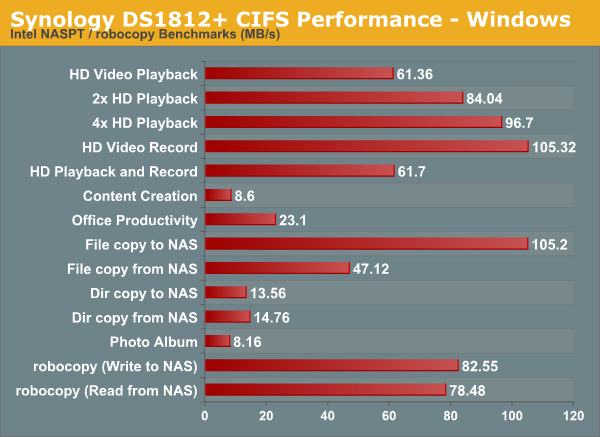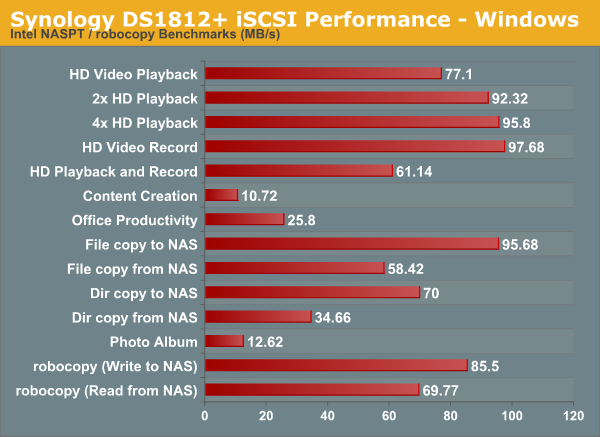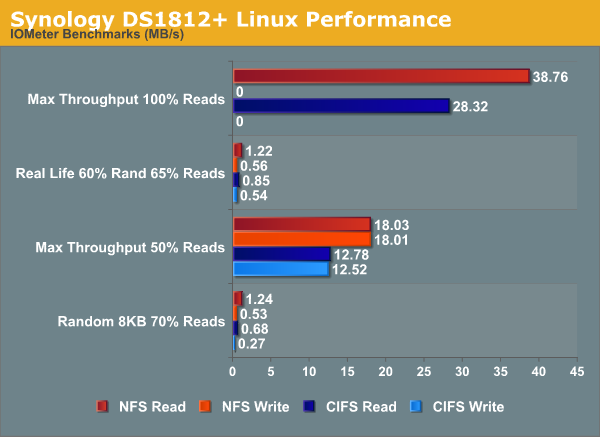Synology DS1812+ 8-bay SMB / SOHO NAS Review
by Ganesh T S on June 13, 2013 4:00 PM EST- Posted in
- NAS
- Storage
- Synology
- Enterprise
Single Client Performance - CIFS, NFS and iSCSI
The single client CIFS performance of the Synology DS1812+ was evaluated on the Windows platforms using Intel NASPT and our standard robocopy benchmark. This was run from one of the virtual machines in our NAS testbed. All data for the robocopy benchmark on the client side was put in a RAM disk (created using OSFMount) to ensure that the client's storage system shortcomings wouldn't affect the benchmark results

We created a 250 GB iSCSI target and mapped it on the Windows VM. The same benchmarks were run and the results are presented below.

A CentOS 6.2 virtual machine was used to evaluate NFS and CIFS performance of the NAS when accessed from a Linux client. In order to standardize the testing across multiple NAS units, the following parameters were used to mount the NFS and Samba shares:
mount -t nfs NAS_IP:/PATH_TO_NFS_SHARE /PATH_TO_LOCAL_MOUNT_FOLDER -o async,hard,proto=tcp,noac
mount -t cifs //NAS_IP/PATH_TO_SMB_SHARE /PATH_TO_LOCAL_MOUNT_FOLDER -o directio
Note that we have not tried to optimize NFS performance for the NAS. In order to keep things as uniform as possible, we will just look at comparative performance on the basis of the default mounting options combined with the above (which are set to avoid caching effects on the client side). The scripts available here were run on IOMeter. The graph below presents the various results.











93 Comments
View All Comments
SirGCal - Monday, June 17, 2013 - link
OK, while you're pulling your many TB down from whatever backup service over your internet connection, also killing your internet pipe, slowing it down for everyone in the process for likely weeks or months to get the pull unless your one of the few on fiber or FIOS, I'd rather not have to repopulate 24-28TB of data from backup in the first place. Good luck with that. While I do keep a backup, it's far better not to need it.Jeff7181 - Tuesday, June 18, 2013 - link
Who sad anything about "cloud" backup? Buy additional high capacity drives and only spin them to perform backups.SirGCal - Sunday, June 16, 2013 - link
UPDATE ON SYNOLOGY:We were finally able to get the Subsonic module loaded and working on it properly and it works fine for music... mostly. But it doesn't have the horsepower to transcode bluray content, even just one viewing, on the fly. I don't know if it's memory or CPU or both but even over the local network (which is disgustingly overkill) it just can't do it. Choppy, stutters, etc. where as mine is smooth and uses ~ 10% CPU or less. I wouldn't think it was that hard on the CPU but... We're still trying to get this to work as it is one of the requirements for him to keep/use this box.
name99 - Friday, June 14, 2013 - link
Forgive me if this is a stupid question, but what's the reason for USB and eSATA ports on a box like this? I understand the basic point of a NAS (as a single box where I can dump a buncha drives and have the HW provide some level of RAID) but how do the USB/eSATA ports play into this?Is the idea that, after I have filled this thing up with 8 internal drives but I need still more space, I start adding drives via the external ports?
SirGCal - Friday, June 14, 2013 - link
There are ways to extend the array, but honestly it becomes a point where the most reliable way becomes to buy or build another array. Doing it as a server in box, you can do 8/12/16/24 drive configurations... This stand alone is the first 8 box setup I've seen aside from rack servers which obviously are true rigs costing a LOT more.name99 - Friday, June 14, 2013 - link
You don't need to convince me. I've built my storage around 5-yr old Macs connected to a bunch of 5-yr old drives using Apple RAID and AFP. Maybe not the right solution for everyone, but meets my needs, and basically free.But that's not the point. My question remains. For the people who ARE the target for this sort of device, what's the point of the USB/eSATA parts. Our reviewer, for example, wanted USB ports in front of the box. Why? What would he do with them?
SirGCal - Friday, June 14, 2013 - link
Sorry, According to their own site, you can use two of their own Synology DS513s to increase the capacity to 18 drives. However 18 drives even as RAID 6 becomes not so hot. 8-12 drives is about my limit. At 16 I make two RAID groups and then one volume for the virtual array cluster to use the data from. Then you have 4 parity drives but much better drive protection crossed the array instead of just 2 drives of parity. That's another discussion though. They sell bigger boxes though that I think actually do this type of configurations though. I'd have to research it though. But even their reported numbers don't show great performance. Still should be OK for most home use.If you want to plug in a single drive and just add it as a shared folder, I think it will do that. I can ask my friend to give it a go if he gets home and see if ya like.
name99 - Friday, June 14, 2013 - link
I think I have a feeling now, from what both you and Ganesh have said.Seems a strangely limited market, to have an environment that wants so much storage, but no-one is willing to just use one of the machines around to plug a drive into and have it act as a file server. But, I guess, I'm not the target audience.
SirGCal - Saturday, June 15, 2013 - link
Ya, that's the catch. For what it is, it's not bad. But the biggest problem in my eyes is that's all it is. It can't do the "other" things that a server could do such as run the other software packages that my servers do... Or at least we haven't figured out how to make it do so yet. We've been beating the pants off my friends rig trying to make it run something like Subsonic which is a media streaming service to stream your own media files to your self when your offsite. Music and videos... I love it and he was hoping to use it also but isn't getting his Synology box to run anything this complicated yet. In some ways I'm actually a bit surprised since it's just a java daemon. (in windows it's a service). I thought of all my software tools, this one might actually work. And there might be a way, we haven't tried hard yet. Or the other fear is the actual CPU won't be capable of trans-coding on the fly... at least videos. We're pretty sure the software will install, but the Atom's are pretty weak. We'll see.. Worst case I guess, we setup yet another server to feed off it for the streaming. Sort-of defeats the purpose but... If it can't do it...Micke O - Monday, June 17, 2013 - link
The drives in each DS513 must be it's own volume. No BIG volume with all the drives in the main unit and the expansion units is possible.